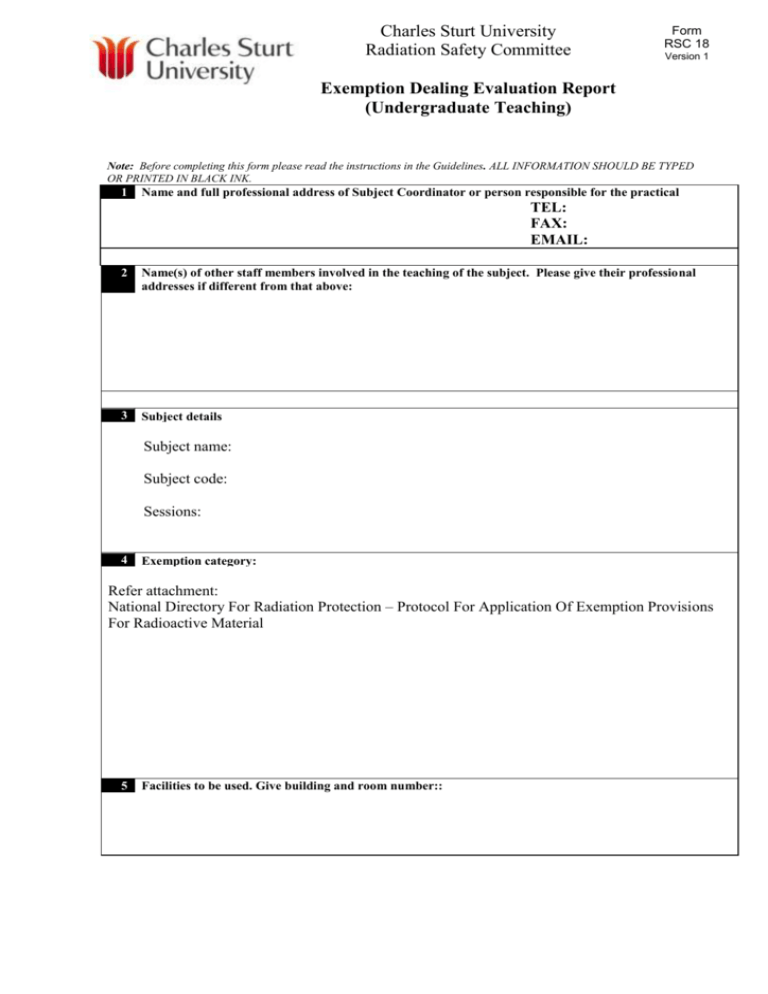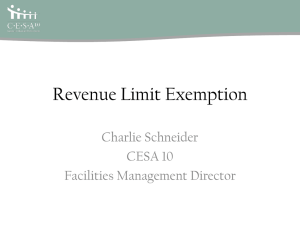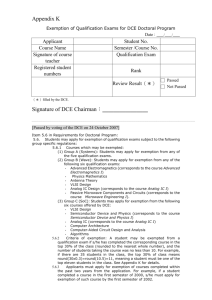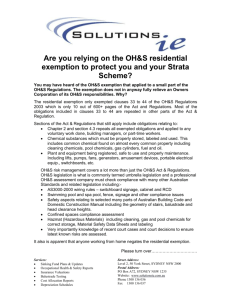RSC 18 - Charles Sturt University
advertisement

Charles Sturt University Radiation Safety Committee Form RSC 18 Version 1 Exemption Dealing Evaluation Report (Undergraduate Teaching) Note: Before completing this form please read the instructions in the Guidelines. ALL INFORMATION SHOULD BE TYPED OR PRINTED IN BLACK INK. 1 Name and full professional address of Subject Coordinator or person responsible for the practical TEL: FAX: EMAIL: 2 Name(s) of other staff members involved in the teaching of the subject. Please give their professional addresses if different from that above: 3 Subject details Subject name: Subject code: Sessions: 4 Exemption category: Refer attachment: National Directory For Radiation Protection – Protocol For Application Of Exemption Provisions For Radioactive Material 5 Facilities to be used. Give building and room number:: 6 Waste disposal - describe: The RSC has evaluated the use of the radioactive materials and has determined that it is an exempt dealing as specified in the National Directory For Radiation Protection – Protocol For Application Of Exemption Provisions For Radioactive Material RSC Presiding Officer …………………………………………………………... Name …………………………………………………………... . . . / . . . . / . . . . Signature Date NATIO NAL DIRECTORY FOR RADIATION PROTECTION – PROTOCOL FOR APPLICATION OF EXEMPTION PROVISIONS FOR RADIOACTIVE MATERIAL The schema for exemption for radioactive material is set out in Part 3.2 (3.2.1 to 3.2.5) of the National Directory Edition 1.0 (the Directory). Schedule 4 of the Directory list exemption levels for radionuclides and the rationale for the exemption levels is described in Annex 2. This protocol sets out the procedures to be followed by the Authority and the person responsible for a practice involving radioactive materials in applying the exemption schema. 1. Exclusion Before addressing exemption, the Directory states that ‘unmodified concentrations of radionuclides in most raw materials, unless otherwise specifically identified in this Directory’ are excluded from regulation as being exposures whose magnitude or likelihood are essentially not amenable to control. The recently published IAEA Safety Guide: Application of the Concepts of Exclusion, Exemption and Clearance (RS-G-1.7) suggests that for radionuclides of natural origin (other 40 than K) an activity concentration of 1 Bq/g may be used, with account taken of a graded approach for materials containing concentrations above this level, for the purposes of exclusion. The idea of a graded approach is included in the Directory at 3.2.5 and will be discussed later. The IAEA Safety Guide goes on to say that there are some situations (such as the use of some building materials containing natural radionuclides) for which exposures from materials due to radionuclides with activity concentrations below 1 Bq/g would necessitate consideration by the regulatory body for some types of regulatory control. Regulatory bodies should retain the authority to investigate such situations and to take whatever action is considered necessary. Jurisdictions agree that, for normal exposure situations, the concept of exclusion generally applies to exposures from materials with radionuclides of natural origin below 1 Bq/g. 2. General Criteria for Exemption The concept of exemption applies to dealings with radioactive material – use, manufacture, storage, transport, selling, possessing, installation, operation, maintenance, repair, or disposal. The general criteria for exemption are set out para 3.2.1 of the Directory. Broadly speaking they are that: first, the health risks associated with the particular dealing with the radioactive material are very low; and second, there is no reasonable radiation protection option (economic and social factors being taken into account) that can be taken to reduce them. This definition of the general criteria for exemption is made in the context of practices or dealings that are ‘justified’. That is, it has been demonstrated that there is a net benefit to the practice or dealing being undertaken. 3. Exemption on the basis of Schedule 4 of the Directory (3.2.2(a)) The first way in which a practice may be exempted is where the radioactive material has an activity concentration or a total activity less than the values provided in Schedule 4 of the Directory. The rationale for the values in Schedule 4 is described in Annex 2 of the Directory. Basically, calculations based upon moderate quantities of material and a wide range of scenarios have shown that the maximum effective dose to an individual using radionuclides or subsequently exposed will be less than 10 µSv per year under plausible normal circumstances and effective doses from accidents, misuse or unexpected situations should be below 1 mSv in a year. With regard to transport, the Code of Practice for the Safe Transport of Radioactive Material allows for exemption from transport regulation of natural material and ores containing naturally occurring radionuclides provided the activity concentration of the material does not exceed 10 times the values in Schedule 4. Jurisdictions agree that all dealings with radioactive material below the activity concentration or activity levels in Schedule 4 of the Directory are exempt from regulation without approach to the Authority. In relation to the transport of radioactive material, the exemption levels established in the Code of Practice for the Safe Transport of Radioactive Material apply. 4. Exemption on the basis of trivial dose (3.2.2(b)) The second means of exemption applies where the activity concentration or activity falls above the levels in Schedule 4, but where it is possible to demonstrate that the dealing or practice involving the material results in less than the 10 µSv criterion above. That is, the scenarios that are relevant to the dealing with the material result in only this trivial level of dose. The applicable scenarios and the approach to the calculations is a matter that needs to be agreed by the Authority. Jurisdictions agree that, subject to the agreement of the Authority on the applicable scenarios and method of calculation to be applied, dealings with radioactive materials involving activity concentrations or activities greater than Schedule 4 but which are demonstrated through the calculation of doses from applicable scenarios to result in doses similar to those on which Schedule 4 is based are exempt. 5. Exemption on the basis of optimisation (3.2.3) This third path to exemption is that most likely to be applied in the case of dealings involving quantities of naturally occurring radioactive materials. The exemption is subject to conditions that may be determined by the Authority, such as requirements for reporting and monitoring, and it is on the basis that an assessment for the optimisation of protection shows that exemption, from say licensing or registration, is the optimum option. Optimisation is taken to mean in relation to any source within a practice that the magnitude of individual doses, the number of people exposed, and the likelihood of there being exposures where these are not certain to be received (eg accidents, intrusions into repositories) are all kept as low as reasonably achievable, economic and social factors being taken into account. The general criteria for exemptions stated above make clear that the cost of regulatory control is a part of the optimisation process – it is one of the economic and social factors to be taken into account. A simplified statement of this form of exemption may be that: The practice is justified The doses arising from the practice – actual and potential – are tolerable Regulation to reduce the doses is not economically or socially warranted. ICRP has stated the principle as being exemption where ‘no reasonable control procedures can achieve significant reduction in individual and collective doses.’ In the application of this principle in overseas jurisdictions, various individual dose levels have been applied, but all ranging in the region of some tenths to about a mSv per year. Jurisdictions agree that exemptions will be granted for practices (generally expected to be dealings involving quantities of naturally occurring radioactive materials) resulting in individual doses up to about 1 mSv per year on the basis of an assessment to be agreed between the operator and the Authority that the radiation protection is optimised. Such an exemption may be subject to monitoring and reporting conditions to ensure that the basis for the exemption remains in place. 6. Not exempting an otherwise exempt practice (3.2.4) It may be in exceptional circumstances that a practice will come to light or be proposed that involves activity concentrations or activities below those in Schedule 4, but where it can be demonstrated that the 10µSv individual dose limit is exceeded. This might occur if the exposure arising from the practice is unconventional and not taken into account by the scenarios that underpin the values in Schedule 4. In such circumstances, an exemption is not appropriate. But the onus should be on the Authority to demonstrate that the doses exceed the basis for Schedule 4 for the particular practice. Jurisdictions agree that material or practices otherwise exempted through the operation of Schedule 4 of the Directory will only be subjected to regulation if the Authority can demonstrate that the magnitude of individual doses, the number of people exposed and the likelihood that potential exposure will occur significantly exceed the values upon which the exemptions in Schedule 4 are based. 7. The graded approach (3.2.5) The Directory makes clear that exemption is not an all or nothing thing. The stringency of the regulatory measures to be applied when a practice is not exempt is to be proportionate to the risk associated with the material. In the first instance, a graded approach would mean that the limits of Schedule 4 and the doses that form the basis of the exemptions in 3.2.2(b) and 3.2.3 are not interpreted as absolute limits, but rather as approximations. It would thus not be expected that a jurisdiction would necessarily reject exemption on the basis of a calculation of a dose to an individual of, say, 18 µSv. It is expected that common sense judgement is applied. If material and a practice is not exempted, the particular application of a graded approach will depend upon an analysis of the practice. Jurisdictions agree that a graded approach will be applied to material and practices commensurate with hazard. SUMMARY OF THE PROTOCOL ON THE APPLICATION OF EXEMPTION IN THE NATIONAL DIRECTORY. Jurisdictions agree that: for normal exposure situations, the concept of exclusion generally applies to exposures from materials with radionuclides of natural origin below 1 Bq/g. all dealings with all radioactive material below the activity concentration or activity levels in Schedule 4 of the Directory are exempt from regulation without approach to the Authority. In relation to the transport of radioactive material, the exemption levels established in the Code of Practice for the Safe Transport of Radioactive Material apply. subject to the agreement of the Authority on the applicable scenarios and method of calculation to be applied, dealings with radioactive materials involving activity concentrations or activities greater than Schedule 4 but which are demonstrated through the calculation of doses from applicable scenarios to result in doses similar to those on which Schedule 4 is based are exempt. exemptions will be granted for practices (generally expected to be dealings involving quantities of naturally occurring radioactive materials) resulting in individual doses up to about 1 mSv per year on the basis of an assessment to be agreed between the operator and the Authority that the radiation protection is optimised. Such an exemption may be subject to monitoring and reporting conditions to ensure that the basis for the exemption remains in place. material or practices otherwise exempted through the operation of Schedule 4 of the Directory will only be subjected to regulation if the Authority can demonstrate that the magnitude of individual doses, the number of people exposed and the likelihood that potential exposure will occur significantly exceed the values upon which the exemptions in Schedule 4 are based. a graded approach will be applied to material and practices commensurate with hazard.






